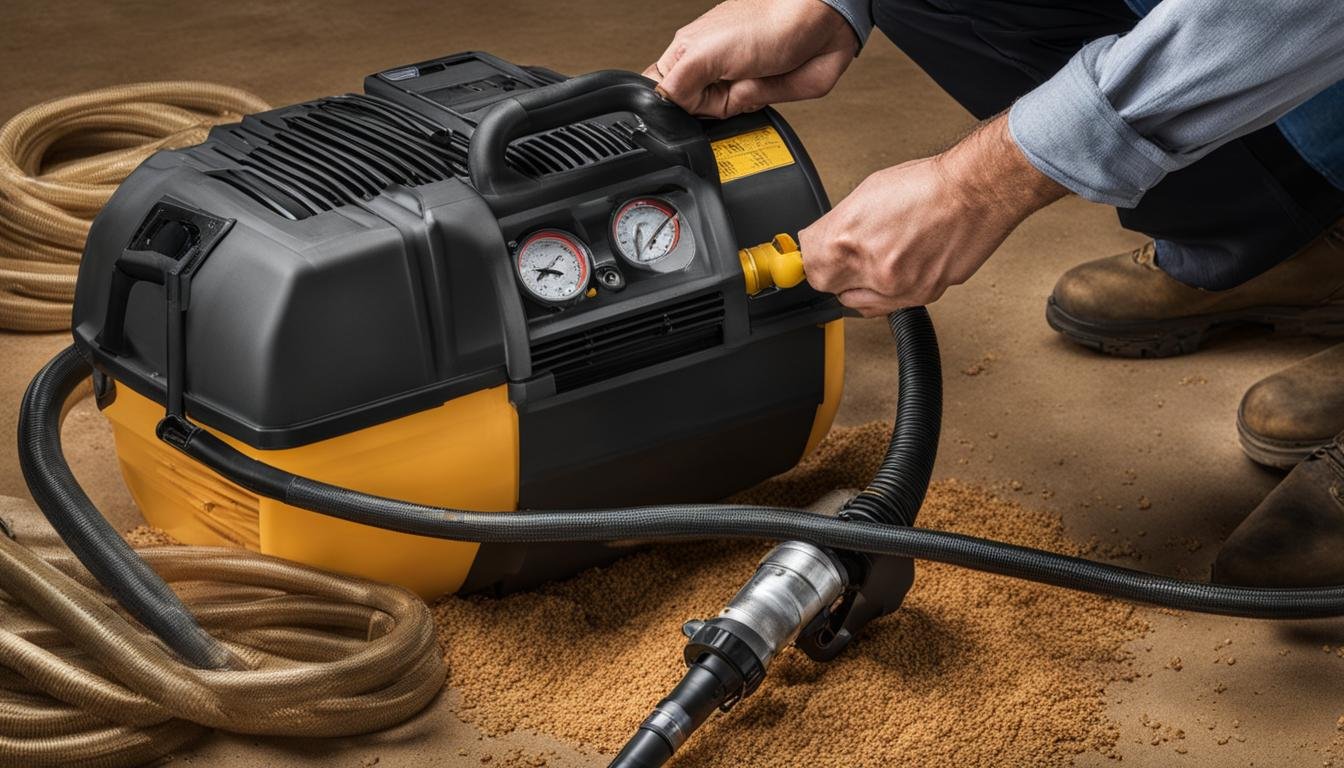Making a vacuum cleaner with an air compressor is a fascinating DIY project that allows you to transform everyday items into a powerful cleaning tool. By utilizing the force of compressed air, you can create a homemade vacuum cleaner that is both efficient and cost-effective.
While traditional vacuum cleaners rely on mechanical vacuum pumps, the air compressor method utilizes vacuum eductors or venturi to generate suction. These devices utilize a specialized nozzle to create a suction effect when compressed air is passed through them. This means that you can achieve similar cleaning power without the need for a mechanical vacuum pump.
It’s important to note that while this method is effective, it can be more energy-intensive than using a mechanical vacuum pump. Compressed air-powered vacuum generators consume about 10 times the power for the same flow rating. Therefore, it is crucial to consider the cost of using compressed air for vacuum generation, especially for continuous duty applications. However, this DIY project can be a viable option for low duty cycle applications, where the air consumption can be minimized to reduce costs.
Key Takeaways:
- Making a vacuum cleaner with an air compressor is a DIY project that allows you to transform ordinary items into a powerful cleaning tool.
- Vacuum eductors or venturi devices utilize compressed air to create suction, eliminating the need for a mechanical vacuum pump.
- Using compressed air for vacuum generation can be more energy-intensive and costly than using a mechanical vacuum pump.
- Consider the duty cycle and application requirements when deciding to use a mechanical vacuum pump or a compressed air-powered generator.
- Proper control and minimizing air consumption can make compressed air-powered vacuum generators more economically viable for low duty cycle applications.
Steps to Make a Vacuum Cleaner with an Air Compressor
To make a vacuum cleaner with an air compressor, follow these simple steps:
- Locate the air intake on your air compressor, usually positioned after an air filter. Remove the air filter or cover to access the intake hole directly.
- Connect a coupling connector or adapter that is compatible with your air compressor on one end and suitable for your needs on the other end. This coupling or adapter will allow you to attach the vacuum hose.
- Note: If you’re using a specific type of coupling, ensure that you do not run the air compressor without it attached to avoid damaging the compressor.
- If you plan on using the compressor as a vacuum pump for materials other than clean air, you will need a reservoir tank between the materials and the air intake.
Using an air compressor as a vacuum pump is not its intended purpose, so proceed at your own risk and take necessary precautions to prevent accidents or damage.
Table: Pros and Cons of Making a Vacuum Cleaner with an Air Compressor
| Pros | Cons |
|---|---|
| Cost-effective DIY project | Energy-intensive compared to mechanical vacuum pumps |
| Suitable for low duty cycle applications | Increased air consumption |
| Allows customization for specific needs | May require additional components and precautions |
Conclusion
Building a vacuum cleaner with an air compressor can be a great DIY project for specific applications. While compressed air-powered vacuum generators may consume more energy compared to mechanical vacuum pumps, they can be a cost-effective choice for low duty cycle tasks. When deciding between a mechanical vacuum pump or a compressed air-powered generator, it’s crucial to consider the duty cycle and application requirements.
By following the necessary steps and taking proper precautions, you can successfully create your own vacuum cleaner using an air compressor. Remember to use appropriate fittings, never run the compressor without the necessary attachments, and be mindful of the limitations when transforming an air compressor into a vacuum pump.
With the right setup, you can enjoy the benefits of a DIY vacuum cleaner hack. Whether you’re tackling small cleaning projects or experimenting with innovative solutions, the air compressor vacuum cleaner can be a convenient tool for your specific needs. So get ready to build your own vacuum cleaner and enjoy the satisfaction of a successful DIY project.
FAQ
Can I make a vacuum cleaner using an air compressor?
Yes, it is possible to make a vacuum cleaner with an air compressor by using vacuum eductors or venturi devices.
How do vacuum eductors or venturi devices work?
Vacuum eductors or venturi devices use compressed air flowing through a specialized nozzle to create suction, eliminating the need for a mechanical vacuum pump.
Is using an air compressor for vacuum generation energy-intensive?
Yes, using compressed air for vacuum generation can be energy-intensive, consuming about 10 times the power of a mechanical vacuum pump for the same flow rating.
When should I consider using a mechanical vacuum pump instead of an air compressor?
If you have continuous duty applications, a mechanical vacuum pump may be more cost-effective than using an air compressor for vacuum generation.
Are air compressor-powered vacuum generators cost-effective for certain applications?
Yes, for low duty cycle applications, compressed air-powered vacuum generators can be a more economically viable option.
What precautions should I take when converting an air compressor into a vacuum cleaner?
When converting an air compressor into a vacuum cleaner, it is important to use proper fittings, avoid running the compressor without the necessary attachments, and be aware of the limitations of using an air compressor as a vacuum pump.





Leave a Reply